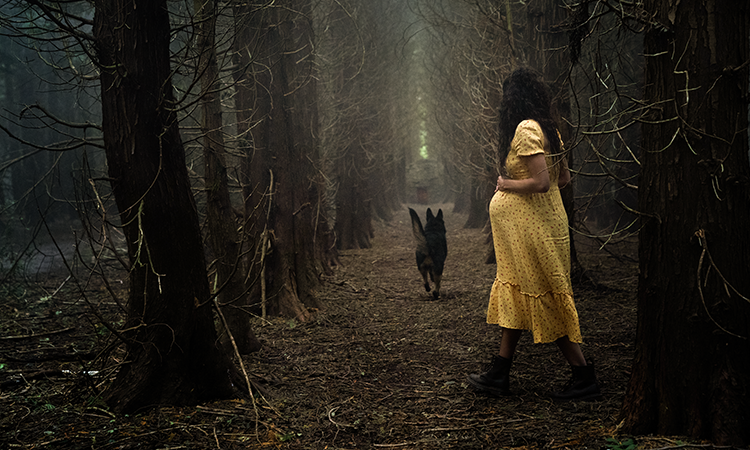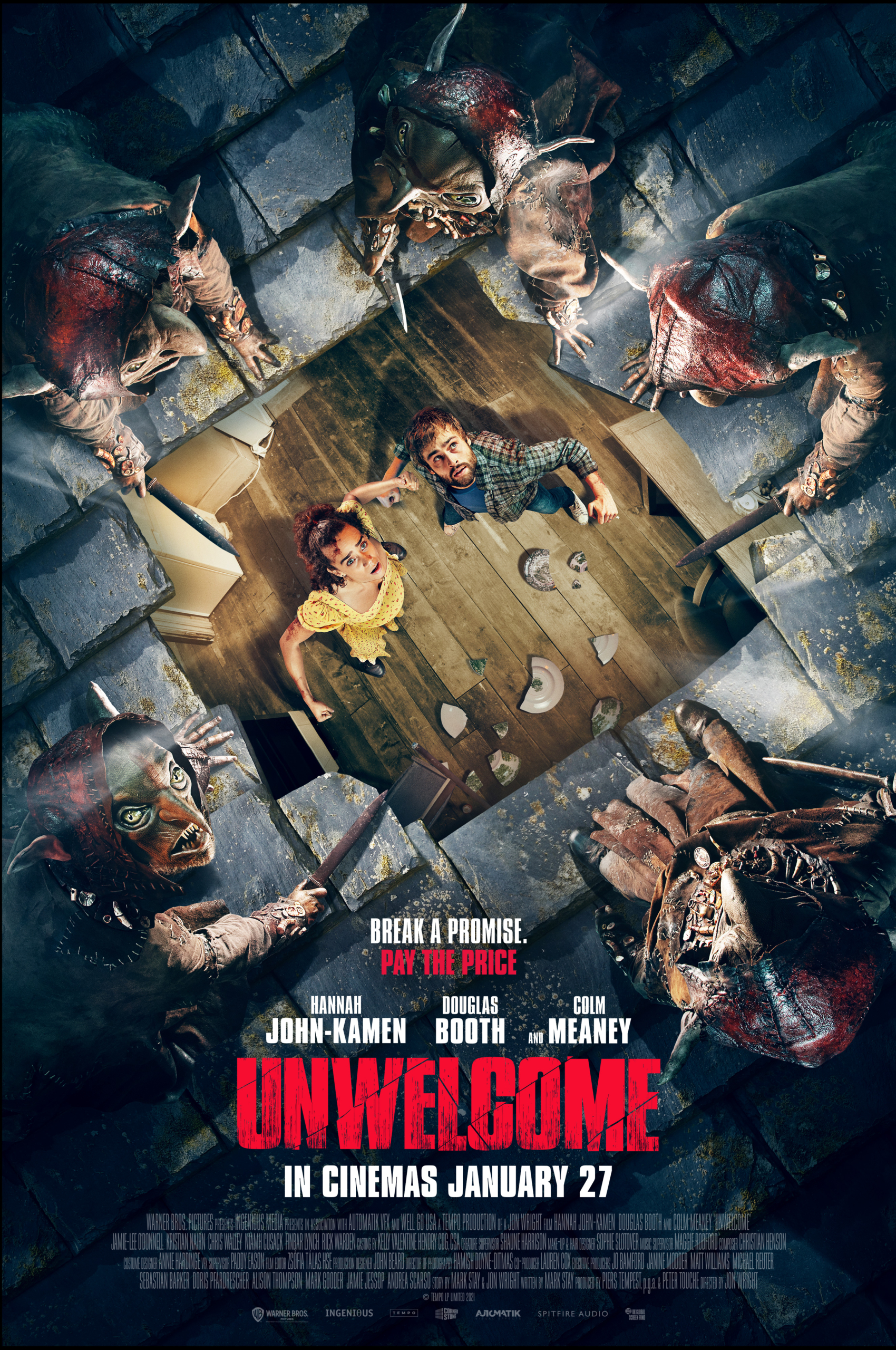Unwelcome stars Hannah John-Kamen and Douglas Booth as Maya and Jamie, a couple who escape their urban nightmare to the tranquility of rural Ireland.
However, when they get there not only do they find themselves at the mercy of a family of rogue traders, but that malevolent, murderous goblins (or Redcaps as they’re known locally) are lurking in the gnarled, ancient wood at the foot of their new garden. Perhaps they haven’t escaped their nightmare after all…
Directed by Jon Wright (Grabbers), Unwelcome is based on an original screenplay by Mark Stay and also stars Colm Meaney, Jamie-Lee O’Donnell, Chris Walley and Kristian Nairn.
The film has also reunited the Grabbers creature team; including prosthetics by Shaune Harrison who has worked on the Harry Potter films, Star Wars: The Phantom Menace and Avengers: Age of Ultron along with creature designs by Paul Catling (Maleficent, Thor, Fantastic Beasts) and longtime Wright collaborator VFX supervisor Paddy Eason (28 Weeks Later, Harry Potter and the Prisoner of Azkaban, Grabbers).
We sat down with director Jon Wright to speak to him about creating the Redcaps and why he wants Unwelcome to be a modern Gremlins…
Unwelcome is a very apt title for the film as there are a lot of unwelcome characters – not just the goblins…
We hoped the assumption would be that the goblins are the problem. And obviously, the goblins are a big problem in this film, but really the bigger problem is the family of Irish builders [the Whelan family] that come and gradually fall out with this young English couple…
Unwelcome is pretty violent, especially at the beginning, was it always your intention to start the movie this way?
I’ve really made this movie for myself, in the best way. All the decisions that I’ve taken all the way along are like: ‘What would I like to see at this particular moment?’ and for me, I wanted the film to set out its stall and say: ‘Look, this is the kind of film that this is. This is the level that we can get to and where we can go to.’
I always liken the movie to a roller coaster ride, where you’re going up that ratchety slope all the way up to the top, and it’s quite a long ride, and there’s lots of nice scenery to look out on the way up but really, the exciting bit of the movie is the drop. That comes in the final third where we try and push the intensity to the maximum level.
So for me, that beginning was a way of saying ‘hang on for the drop’. We’ll just give you a little drop now, and then you can hang on for later, and there’ll be lots of talking and character stuff, which is really important because you’ve got to learn what these people are all about, but there’s going to be lots of fun and excitement at the end and you hopefully leave the cinema or your living room and you’ll feel: ‘Okay I got my money’s worth. I had fun. It was a Friday night movie!’
The violence is even more disarming as the movie looks like it could be a romance or musical. Why did you decide for the movie to look this way?
The director of photography, Hamish Doyne-Ditmas, is a big fan of musicals. We thought of this as a Grimm fairy tale for adults. It’s not something you want your children watching, and I think adults enjoy that type of tale just as much.
There are lots of echoes of things like Hansel and Gretel, and Rumplestiltskin even, so we pushed the look of the film. We wanted it to have that slightly heightened fairytale quality. That Tim Burton feeling where you’re not sure if it’s a set or if you’re outside, to give the audience a feeling that they might be dreaming almost.

How much of the movie was shot on location and how much was a set?
The house itself was a massive set. I mean, one of the biggest sets I’ve ever shot on. One of the positives of coming out of Covid was that they were very keen for us to shoot on a stage. So that’s a set and then the exterior locations are in Ireland. They’re in a lovely part of Ireland, a town called Cong, where they shot The Quiet Man, which is probably one of the most picturesque towns in Ireland I think.
So it’s a hybrid because the interior stage was actually near Watford, in an airfield – not in a particularly glamorous or Irish location at all! But I hope you can’t tell that that’s the case.
Unwelcome has a brilliant array of characters – is there a particular character or characters you’re excited for audiences to meet?
Well, I think audiences are going to love to hate the Whelan family.
We were very lucky with that cast. We got a fabulous cast of really great Irish actors to play that family. We’ve got Colm Meaney playing the dysfunctional father. We’ve got Chris Wally from Young Offenders playing a sort of horrible, young thug type. Jamie-Lee O’Donnell from Derry Girls plays a horrible thug as well. And then Kristian Nairn plays, I think, quite an interesting character. Maybe not what you’d expect. So first you think he’s almost like Jaws from the James Bond films, like a silent giant, but then as the film progresses you realise there’s a lot more going on with him.
The relationship in the family is complicated and I think all those actors just took so much pleasure in playing them. It was great for them because they felt like they were off the hook and could be really horrible and very unlikable and funny as well. So they bring quite a lot of humour and they just took glee in being that unlikable.
We screened the film recently at Sitges and when the Whelans get in trouble, there were huge cheers and applause and clapping. They’re the family you love to hate, so I’m really looking forward to people getting to meet them.
What were your inspirations for the look of the goblins in Unwelcome?
I always felt that if Redcaps were really real, if they were actual living, breathing creatures that lived in a wood, they’d have been discovered in this day and age. They’d be on people’s camera phones and they’d be tracked down by GPS. So it was quite important to me that they’re magical creatures, that if you go into the woods looking for them, but you don’t need the Redcaps, you’ll never find them. So because they’re magical, that gave us quite a lot of creative licence.
They’re not really a family of creatures. They’re very different looking from each other. Some have big hooked noses and some have tiny noses and huge eyes and some have tiny eyes, some have huge teeth… they’re all very varied.
I basically just sat down with a piece of paper and just drew (I’m no great artist by any stretch of the imagination), but I just drew every kind of weird and wonderful goblin that I could on a piece of paper and I didn’t censor my thoughts at all. So it didn’t matter how they came out.
Then I gave that illustration to Paul Catling, who is this fantastic concept artist who’s worked on these huge movies like Harry Potter and Marvel movies and Star Wars and he turned them into these amazing 3D illustrations. He really took those original goofy sketches and ran with it. So we end up with this very colourful, dysfunctional-looking, strange, weird and wonderful group of creatures who couldn’t really genetically be related to each other, but we don’t worry about that because these are magical creatures that have lived for thousands of years.
If you look closely at what they wear, you’ll see modern-day things like bottle tops and beer can ring pulls, and you’ll see things from hundreds and hundreds of years ago, so they’re actually ancient creatures that appear and disappear at will.
We had a lot of fun designing those. And Shaune Harrison, who is a brilliant creature effects guy who worked on Harry Potter for many years, made all the masks of the goblins and did an amazing job.

What was the process of bringing the Redcaps to life?
I was very keen not to have fully CG creatures. I wanted to photograph something. So we went back to a movie that I remember from my childhood called Cat’s Eye, which is a Stephen King adaptation with Drew Barrymore. In that they had a little goblin running around. It was basically a person in a costume running around on an absolutely giant set. That always stayed with me because of how it looked.
So in the end, we built double-height sets. We had full-size actors wearing masks, dressed in those outfits with swords and all the rest of it, running about on double-height sets. So when that first Redcap appears and he opens the French doors, he’s actually opening a 12ft French door!
But the problem with films like Cat’s Eye and Gremlins – which is a big inspiration of mine and a big inspiration for this movie – is when you get a big close-up of the Gremlins, the faces look a bit rubbery and unconvincing. So we used CG for that – we have a physical mask that is very photorealistic, and then we modelled that again in CG and basically animated it in CG.
We motion-captured an actor who is an old friend of mine called Rick Warden, who played all of the goblins. He did all the voices, and he went into ridiculous detail about the differences in their personalities. I don’t know if you’ll get it on the first view. I think you’ll just see a group of malevolent goblins who look a bit different but maybe on a second or third viewing you might pick up that they have very different and distinct personalities. Rick went a long way into that.
Unwelcome mixes comedy with horror. How did you go about nailing the right tone for the movie?
I think tone is really important. I learned this the hard way because I made a film called Tormented where I didn’t have a firm handle on the tone. I think when I made Grabbers, I had a much better idea that if something is funny, that can be very seductive because it makes you laugh, but if it breaks the tone of the movie, you have to let it go.
At the same time, you might have something that’s incredibly dramatic, but if it’s too dark and depressing and morbid, that’s going to equally break the tone in the other direction. So you’ve got to let that go as well. It’s kind of a tightrope walk.
It was important to me that the film was about something and one thing that made me excited to make a horror movie again was watching films like Hereditary and Get Out. They felt like a real departure from the torture porn era, that they were horror films, definitely and they are in the genre. They deliver all the stuff that you expect of the genre, but they have something to say and they have an interesting point of view on modern life and they don’t shy away from sociological issues.
That’s kind of the ambition for the film – to make one of those modern-style horrors that are more thought-provoking and have things to talk about. To take something that’s really fun, like Gremlins and bring it into the modern era.
Unwelcome is released in cinemas on 27 January 2023. Read our review here.
